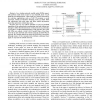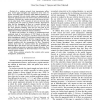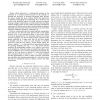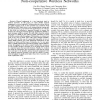ICNP
2007
IEEE
14 years 6 months ago
2007
IEEE
Abstract— In a wireless network, mobile nodes (MNs) repeatedly perform tasks such as layer 2 (L2) handoff, layer 3 (L3) handoff and authentication. These tasks are critical, part...
ICC
2007
IEEE
14 years 6 months ago
2007
IEEE
—In a wireless network, data transmission suffers from varied signal strengths and channel bit error rates. To ensure successful packet reception under different channel conditio...
GLOBECOM
2007
IEEE
14 years 6 months ago
2007
IEEE
Abstract— Nodes in multi-hop wireless networks, and specifically in ad-hoc and mesh networks, are being increasingly equipped with multiple wireless network interfaces (radios) o...
CISS
2007
IEEE
14 years 6 months ago
2007
IEEE
—Network coding and cooperative diversity have each extensively been explored in the literature as a means to substantially improve the performance of wireless networks. Yet, lit...
CISS
2007
IEEE
14 years 6 months ago
2007
IEEE
— Two fundamental properties of wireless networks, the variable link quality and the broadcast nature of the transmission, have often been ignored in the design of routing protoc...
AINA
2007
IEEE
14 years 6 months ago
2007
IEEE
— Simulation is the most famous way to study wireless an mobile networks since they offer a convenient combination of flexibility and controllability. However, their largest dis...
WMTE
2008
IEEE
14 years 6 months ago
2008
IEEE
With the popularization of the wireless network, and the progress of mobile computing technology, the efficiency of the hand-held device is better, and its applications are wider....
WCNC
2008
IEEE
14 years 6 months ago
2008
IEEE
—in this paper, we present a new policy for admitting Voice over IP (VoIP) sessions over wireless networks. Our proposed policy receives the admission information advertised by t...
INFOCOM
2008
IEEE
14 years 6 months ago
2008
IEEE
—Rate allocation is a fundamental problem in the operation of a wireless network because of the necessity to schedule the operation of mutually interfering links between the node...
INFOCOM
2008
IEEE
14 years 6 months ago
2008
IEEE
—Channel assignment is a very important topic in wireless networks. In this paper, we study FDMA channel assignment in a non-cooperative wireless network, where devices are sel�...







